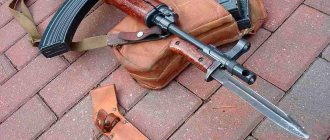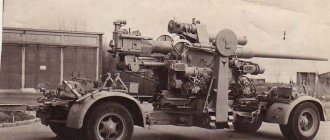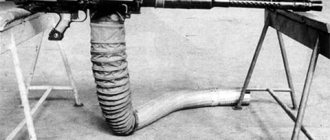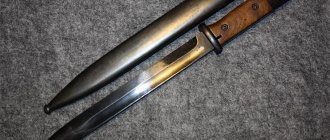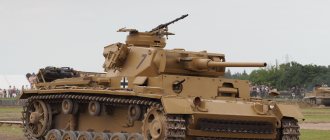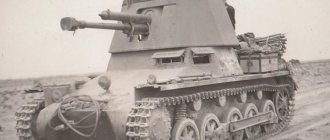First products
Each state entered the Second World War with its own set of weapons. The troops of the USSR and Germany turned out to be the most prepared in this regard, since at that time military operations continued for them.
With the beginning of the war, the need to adapt the knife to the conditions of field battles, battles within the city, and reconnaissance work became obvious. For example, in Germany they modified bayonet knives, hunting daggers and even cutlasses.
A trench knife is a military weapon designed to kill or seriously incapacitate an enemy soldier at close range, as may be found along a trench line or other confined area.
It was developed in response to the need for close combat weapons for soldiers conducting attacks and raids on enemy trenches during the First World War. An example of a WWI trench knife is the German army Nahkampfmesser (close combat knife).
With the outbreak of World War II, the trench knife, by this time commonly called the combat knife, proved so useful that armies continued to develop and produce new designs. On the Axis side, the Nahkampfmesser and the projects developed from it produced both combat and general-purpose service knives for ordinary soldiers.
Allied armies generally limited the issue of trench knives to elite infantry units and infantry not equipped with a bayonet.
Design and material of manufacture
Melee weapons must have the main parameter - efficiency in use. Finka successfully combines a weapon and a productive tool for everyday life. The blade of the classic model is short and sharpened on one edge.
Despite the modest dimensions of the blade, it can easily cut branches or sharpen stakes. Hunters deftly use it when cutting up an animal carcass.
The thick spine allows you to apply additional force to the knife. A high-quality block or handle can withstand impacts with a heavy object on the butt, for example, a mallet or a log. The classic blade size has the following values:
- length – 125 mm;
- width – 20 mm;
- thickness – 4 mm.
Such parameters provide the cutting part with resistance to physical stress. In addition, the blade has longitudinal grooves - valleys, which serve not so much as a blood flow, but as stiffening ribs. A distinctive feature of the finka from many combat specimens is that in front of the handle or guard there is an unsharpened part of the blade - the heel.
This type of sharpening allows the index finger to be placed on the blade in certain grips, which allows you to control the nature of the cut.
In the manufacture of a blade for a Finnish knife, steel from 58 to 62 units is used according to the Rockwell method. In the distant past, a worn hand scythe was an excellent material for the production of the necessary workpiece by Finnish blacksmiths. The structure of the metal lends itself perfectly to cold forging. The process looked like this:
- braids unsuitable for further use were connected together in 2-3 pieces;
- the stacked package was heated and forged until a monolithic bar was formed;
- the forged element was divided into strips and cut into blanks of the required size;
- finished blanks underwent forging and creation of the tail section;
- then handles were attached to the blades with a brass fitting or sleeve attached.
Modern production of various types of Finnish knives includes many technologies. High-carbon steel contains additives from the elements of nickel and chromium, which improves the alloying properties of the metal.
Nickel promotes corrosion resistance, while chromium adds additional strength. But it is worth noting that among the countless number of bladed weapons, there are many specimens made of low-quality steel that look presentable, which you can simply look at, because they are not suitable for use.
The excellent blade material of a real finca allows the blade to remain sharp for a long time. At the same time, proper and timely care of the working surface will prevent unwanted corrosion. It is worth noting that the modern design of Finnish knives uses stainless steel, which is inferior in terms of sharpening life to the original product.
Famous models
Famous models of the Second World War belong to Russian, German, American, and British production. Each state developed its own “national” version of edged weapons.
The NR-40 ("scout knife") was a Soviet combat knife introduced in 1940 and used throughout World War II. The HP-40 has a 152mm blade with a clamp point, black wooden handle and S-shaped guard. The guard is "inverted" (unlike most S-shaped guards, it curves towards the edge). This made it possible to work with a knife using a reverse grip.
Scout knife HP-40.
At the beginning of the 20th century, Finnish puukko knives began to become popular among criminals in most cities of the Russian Empire. Local knife makers then began modifying the Finnish forester's tool to make it more useful for fighting; for example, making the blade longer, changing from a flat back to a pinch point, and adding more protection.
The resulting weapon, still called the "Finnish knife" or "finka" in Russian, looked somewhat different than the typical puukko.
Finnish knives were ubiquitous in the criminal world of Russia and the Soviet Union throughout the first half of the 20th century. Because of the criminal community, the Finnish knife was banned in the Soviet Union in the 1930s, just as the switchblade would later be banned in the West.
The Winter War revealed a number of shortcomings in Soviet weapons; Among other things, the Soviet infantry lacked a good combat knife.
As a result, in 1940, the Soviet army adopted the HP-40, essentially a serial version of the Russian bandit "Finnish".
In the USA, the famous model was the Ka-Bar blade. This is the trademarked, modern popular name for a combat knife first adopted by the United States Marine Corps in November 1942 as the 1219c2 combat knife (later designated the USMC Mark 2 combat knife or combat utility knife), and later adopted by the United States Navy in as a US Navy Mark 2 utility knife.
Additionally, Ka-Bar is the name of the related knife manufacturing company Ka-Bar Knives., Inc. (formerly Union Cutlery Co., New York, subsidiary). Although Ka-Bar Knives, Inc. currently produces a wide range of knives and cutlery, it is best known for the Ka-Bar Fighting/Utility knife, which traditionally used 7-inch (17.8 cm) 1095 carbon steel with a clip and leather handle.
World War II is known for the proliferation of bayonet knives. Designed in 1942 by Wilhelm Gustloff Werke in Suhl and manufactured by Karl Eichhorn in Solingen, the "SG42" was intended to complement and replace the original Karabiner 98 bayonet. Although this was largely proven, there was a shortage of business and utility knives, which were usually purchased privately . The "SG42" was designed as a combat knife, but could also be mounted as a bayonet.
After consistently positive reception of several hundred pieces, the troops gave it a shot in 1943, production was approved by Adolf Hitler, but this had to happen due to the cost of converting production before the end of the war. In 1944, the Army Ordnance Bureau issued an order for 10,000 units, production began, but due to the end of the war only a small number were delivered.
Catalog of bladed weapons
home / more / directory
The Second World War
Bayonets • Knives
All • First World War • Second World War • Post-war
Iranian bayonet. Czechoslovakia
Manufacturer: unknown, Czechoslovakia. Dimensions - 534/400/23/6.2. Weight - 524/754. The handle is made of wood. The blade is carbon steel, single-sided sharpening, fuller on both sides. Czechoslovakian export bayonet mod. 1923 for the Mauser rifle model 1898/29.
Model 1924 bayonet. Czechoslovakia
Manufacturer: Waffenfabrik Bruenn AG, Brno, Czechoslovakia. Dimensions 435/300/23/5.2. Weight - 414/600. The handle is made of wood. The blade is carbon steel, treated with a black anti-corrosion coating, single-sided sharpening, fuller on both sides. Standard bayonet for the 1924 Mauser rifle, produced during the occupation of Czechoslovakia.
German bayonet model 1884/1898. new type. Germany
Manufacturer: Jos. Corts. Sn. AG, Remschaid, Germany. Dimensions - 384/250/25/6. Weight - 446/700. The handle is made of plastic. The blade is carbon steel, blued, single-sided sharpening, fuller on both sides. Standard bayonet for the Mauser rifle mod. 1898, “98b” and “98k” carbines, “33/40” and “98/40” rifles. Manufactured since 1937 by many German army contractors. It is a modernization of the bayonet mod. 1884/1898 a new type, manufactured from 1915 to 1917.
Spanish bayonet model 1943. Spain
Manufacturer: Fabrica National de Toledo, Toledo, Spain. Dimensions - 373/250/32/7. Weight - 508/684. The handle is made of wood. The blade is carbon steel, single-sided sharpening, fuller on both sides. Standard bayonet for the Mauser rifle mod. 1943
Bayonet m/39. Finland
Manufacturer - OY Veljekset Kulmala Konepaja Helsinki, Finland Dimensions - 295/181/25.5/5. Weight - 342/448. The blade is carbon steel, single-sided sharpening, fuller on both sides. The handle is made of wood. Standard 1939 model bayonet for the m/39 “Ukko-Pekka” rifle. Manufactured since 1941 by order of Suomen Suojeluskuntajarjesto (Sk.Y) - the Finnish security corps - skyddskar (Swedish), a voluntary paramilitary organization.
Bayonet No. 4 MkII model 1941. Great Britain
Manufacturer: unknown, UK. Dimensions - 255/203/13. Weight - 236/342. The blade is carbon steel, oval needle-shaped, treated with an anti-corrosion coating. Standard bayonet for the Lee Enfield rifle.
Bayonet model 1871/1887/1916. Italy
Manufacturer: Fabbrica D'Armi Di Terni, Terni, Italy. Dimensions - 360/230/27/7. Weight - 432/582. The handle is made of composite. The blade is carbon steel, treated with a black anti-corrosion coating, single-sided sharpening, fuller on both sides. A shortened version of the bayonet for the Vetterli single-shot rifle mod. 1870 and a Vetterli-Vitali repeating rifle mod. 1870/87. Used until the end of World War II.
Folding bayonet model 1938. Italy
Manufacturer: unknown, Italy. Dimensions - 290/215/180/21/4.5. Weight - 272/402. The handle is made of wood. The blade is carbon steel, single-sided sharpening, fuller on both sides. Standard bayonet for rifles and carbines mod. 1891/1938 and arr. 1938
Bayonet model 1936 USSR
Manufacturer: USSR. Dimensions - 450/335/25/5. Weight - 334/514. The blade is carbon steel, chrome-plated, single-sided sharpening, fuller on both sides. The handle is made of wood. Standard bayonet for ABC.
Bayonet model 1938 USSR
Manufacturer: USSR. Dimensions - 480/360/28/5. The blade is carbon steel, single-sided sharpening, fuller on both sides. The handle is made of wood. Standard bayonet for SVT.
Bayonet model 1940 USSR
Manufacturer: USSR. Dimensions - 360/240/25/5. Weight - 270. Blade - carbon steel, single-sided sharpening, fuller on both sides. The handle is made of wood. Standard bayonet for SVT.
Bayonet model 1944 USSR
Manufacturer: USSR. Dimensions - 385/315/16.5/-. Weight - 300. Blade - carbon steel, tetrahedral needle-shaped, blued. Standard integral bayonet for the Mosin system carbine mod. 1944
M1 bayonet model 1942. USA
Manufacturer: American Fork & Hoe, USA. Dimensions - 363/249/27/6. Weight - 442/586. The handle is made of plastic. The blade is carbon steel, treated with a black anti-corrosion coating, one-and-a-half sharpening, fuller on both sides. Standard bayonet for the Springfield rifle mod. 1903 and the Garand M1 self-loading rifle for arming motorized infantry and cavalry units. Manufactured by the end of 1943 by six companies.
Folding inertial sling knife mod. 1937, Germany
Manufacturer: Paul Weyersberg & Co. Dimensions - 254/154. Sling knife for flight crews and airborne units of the Luftwaffe, intended, among other things, for unraveling parachute lines in the event of an emergency situation when the crew of an aircraft escapes in an emergency, a collapsible version.
Emergency Release Knife, UK
Manufacturer: J.Nowill & Sons. Dimensions - 270/140. The handle is made of wood. The crescent-shaped blade is made of carbon steel, sharpened on one side along the concave part. Standard rescue strop knife of the Royal Air Force since the early 1940s.
Dagger arr. 1943 Switzerland
Manufacturer: Elsener Schwyz Victoria, Switzerland. Dimensions - 340/210/24/6. Uniform officer and non-commissioned officer army dagger.
SA stormtrooper uniform dagger. Germany
Manufacturer: JP Sauer & Sohn, Germany. Dimensions - 348/220/34/5.5. Uniform dagger of the 1933 model of the NSDAP paramilitary forces.
Dagger. Finland
Manufacturer: Hackman & Co. Dimensions - 380/260/20/4. Weight - 174/284. The handle is wood. The blade is carbon steel, double-sided sharpening. Standard Finnish army dagger of the period between the world wars.
Fairbairn-Sykes Commando Knife. Type 1. UK
Manufacturer: Wilkinson Sword. Dimensions - 300/174/22/5. The standard dagger of the British Commandos and SOE (Special Operations Executive), Type 1, was produced from 1940.
Fairbairn-Sykes Commando Knife. Type 2. UK
Manufacturer: unknown. Dimensions - 293/167/22/5. Weight - 234/284. The handle is brass. The blade is carbon steel, double-sided sharpening. The standard dagger of the British Commandos and SOE (Special Operations Executive), Type 2, was produced from 1941.
1
history of weaponsFrom baguette to bayonet-knife
permitsRegistration of weapons (obtaining permits)
saleHow to sell your weapon
storageWho and how often can check the storage conditions of weapons
morePurchase of cartridges, gunpowder, bullets, etc.
licensesPurchase of edged weapons
Knives of the Third Reich
Cold steel weapons of the Third Reich are represented by a large number of models, the meaning of which was largely symbolic. This is a large number of officer daggers (“Heer”, Luftwaffe officer, Kriegsmarine officer), daggers of soldiers of the SA, Feldherrnhalle, Schutzstaffel detachments, daggers of cadets, labor cleavers (cleaver of the command staff of the German Labor Front RAD, cleaver of the rank and file of the German Red Cross DRK), etc. .
In other words, bladed weapons (and other weapons) were a sign of the social group to which the owner belonged. Usually these were dagger or spear-type blades with a pronounced guard.
Knife of the Third Reich.
The handle and blade could be densely decorated with appropriate symbols: eagles, runes, slogans in Gothic font, etc.
Imperial Labor Service (RAD) cutlasses
Labor units were created to combat unemployment and further join the armed forces. During wartime, RAD units worked in occupied cities: clearing debris after bombing, transporting trophies, and building roads.
The daggers were carried by the unit's corporals. Weapon characteristics:
| Length | Width |
| In centimeters | |
| 40 | 4 |
The knife is distinguished by a handle with an eagle's head at the end.
Design Features:
- slightly curved blade with a beveled end;
- one-sided sharpening;
- metal handle with horn pads.
The front side of the blade is decorated with the inscription “Work ennobles” (“Arbeit adelt”). The scabbard was made of nickel and aluminum with a tip resembling a shovel.
Wehrmacht knives
Wartime required the improvement of edged weapons and the adaptation of their properties to battle conditions. The Wehrmacht's task was to constantly experiment with knives. In particular, the 1884 model, created for close combat, was in service.
The modification of the handle, the material of its manufacture changed, and parts were added for additional functions of the blade. A notable feature of that time was the use of bakelite cheeks in the handle . These elements were fastened with several screws. The blade was 25 cm long. It was sharpened on one side, and the fullers were located on both sides: this solution increased the strength of the product.
Wehrmacht trench knife.
Daggers of the National Socialist Motor Corps (NSKK)
The organization was converted from the Automotive Corps and authorized in 1931. Motorized squads were part of the SA assault unit. Since 1934, the NSKK became a separate organization, to which Hitler gave direct orders. Their task was to promote auto tourism and National Socialism, as well as patrol and organize competitions.
Characteristics of NSKK daggers:
| Length | Width |
| In centimeters | |
| 35 | 3,3 |
In appearance, the weapon resembled SA knives. The handle was decorated with the emblem of an assault unit. Model features:
- diamond-shaped blade;
- an eagle with a swastika in the center of the handle;
- guard, repeating the shape of the pommel.
Black knives were made of nickel. Belt chains made of square links with eagles in the center, connected by rings. The carbine was decorated with an image of an acorn and oak leaves.
Since the beginning of the war, an infantry or trench knife with wooden plates without distinctive marks on the handle was adopted. It was shorter than the daggers by 7 centimeters and narrower by 10 centimeters. The blade was sharpened completely on one side, and to the middle on the other side.
Knives SS
The name of the detachment Schutzstaffel means "security squads". The SS was an elite unit, the youngest fighter was at least 21 years old, all of them were extremely carefully physically, intellectually and ideologically prepared. The SS unit joined the ranks of the personal guards of charismatic rulers in world history, whose reputation was based on hatred for cruelty and a mystical horror of the power of the “SS”.
The equipment of the SS soldiers also corresponded to their special status. In addition to the famous SS daggers, which will be discussed below, the detachment was also armed with folding knives. For example, “Pantographic”, which has an unusual design solution. It could be opened and closed manually. At the same time, the mechanism was as reliable as if the blade was fixed. The knife was released in 1937.
Combat dagger-knife CC.
The SS dagger, as a phenomenon in the world of edged weapons, has undergone many editions, which differed from each other in symbolic details such as the inscription on the blade or the use of lower quality metal for the sheath.
This elite attribute is created on the basis of a Swiss hunting dagger, literally “copied” from a 16th-century portrait by Hans Holbein.
Basic parameters of the SS dagger
The dagger of the Schutzstaffel (SS) members was introduced by order No. 1734/33 on December 15, 1933, signed by the interim SA Chief of Staff Obergruppenführer von Krausser. It was a tetrahedral dagger with no fullers, and along the blade the inscription “Meine Ehreheisst Treue” (“My honor is called loyalty”).
The thickly varnished black wooden handle depicts an eagle with a swastika in its talons. Near the pommel there are two zig runes enclosed in a ring. The handle initially had cupronickel metal elements, then nickel-plated zinc and aluminum.
A metal pendant was attached to the handle, replete with Celtic symbols: runes, clover leaves, images of a skull and crossbones, etc. Blade length – 37 cm.
Blade parameters
- length in sheath: 360 – 375 mm;
- length without sheath: 345 – 350 mm;
- double-edged blade;
- length: 220 – 230 mm;
- width: 34 – 35 mm;
- thickness at the heel: 5.5 mm.
Handle
- length of wooden part: 110 mm;
- width: 35 mm;
- thickness: 21 mm.
Daggers of the National Political School (NPEA)
Since 1933, leaders of paramilitary units have been trained in educational institutions of the National Socialist Party. In 1936 they transferred to the SS department. The first distinctive daggers of the school appeared in 1935. Their characteristics:
| Length | Width |
| In centimeters | |
| 35 | 3,3 |
Weapons were first issued to teachers, and then introduced as part of the uniform of senior cadets. Model features:
- straight blade with double-sided sharpening;
- figured wooden handle;
- light engraving on the blade.
The surname and initials were placed on the handle with cupronickel pommel and guard. Later the parts were made of aluminum.
The teachers' knives were distinguished by the image of an eagle on the handle. The leaders of the party school carried weapons in a special way - the scabbard was attached to the sword belt with two chains and a carbine.
Brand on the weapon
During the Third Reich, about a hundred companies were engaged in the production of bladed weapons. This can be explained not only by wartime needs, but also by Hitler's love of steel blades.
Many of the dagger and dirk manufacturers were located in the city of Solingen, which for this reason began to bear the name “City of Swords”. The stigma was a necessity and at the same time a tradition. This sign spoke not only about the manufacturer, but also about the history of the creation of the weapon.
They usually left their brand name under the guard on the flat side of the blade using stamping.
Explanation of markings
Each mark had its own meaning, and it could be deciphered. The knives have undergone quality control. In 1934, an entire commission was created that monitored the production of edged weapons and the price level for them.
Each manufacturing company received a personal number from the Control Service, which could be included in the stamped symbol. The markings of the Eichhorn knife RZM M 7/66/43 can be deciphered as follows:
- RZM is the name of the Service - Reichszengmeistrei;
- M - use of metal in production;
- 7 - type of product - edged weapons;
- 66 is the code of the manufacturer, in this case Eichhorn;
- 1943 is the year the knife was produced.
RZM mark on the dagger.
Today, not all symbols can be deciphered. The values contained in the mark could indicate the number of fighters in the unit or be the personal serial number of the soldier. The stamps provided a lot of information about the military operations of World War II.
Edged weapons of the early twentieth century are not just an evolutionary stage in the quality of knives, it is also a massive layer of historical facts and data, the destinies of people and empires.
Elite Security Forces (SS) Dagger
A special unit was subordinate to SA stormtroopers and monitored Hitler's safety. After the separation, reinforcement units were formed, and then SS troops - military guards. The organization controlled the work of concentration camps, the police and German intelligence services, and also initiated persecution on grounds of race and political opinion.
Characteristics of SS daggers:
| Length | Width |
| In centimeters | |
| 34,7 | 3,3 |
Weapons with distinctive symbols were included in the uniform from 1933 to 1940. Features of early models:
- diamond polished blade, sharpened on both sides;
- ebony handle;
- Nickel plated guard and pommel.
At the end of the handle was a runic emblem with two letters “S”, similar to lightning bolts, and in the center was an eagle with a swastika. The scabbard was made of nickel-plated nickel silver. In 1936, a chain of emblems and skulls appeared on the daggers. Elements of the handle, scabbard and chains were made of cupronickel.
SS daggers from WWII and WWII are distinguished by painted scabbards with nickel-plated details.
I would also like to remember about SEITENGEWEHR 98
Also known as the 98k bayonet/combat knife, no matter what you call it, it is an effective combat knife as well as a tool knife. If you can get close enough to your target, it is a silent and effective killer.
Combat knife SEITENGEWEHR 98.
The Seitengewehr 98 is a close combat weapon first introduced into the German Army as a bayonet for the Mauser M1898 rifle with a 50 cm (19.7 in) blade. In 1905, the Seitengewehr 98/06 replaced the previous blade and was shortened to 37 cm (14.6 in).
In 1908, when the 98 Kurz carbine was introduced as a standard issue short-barreled rifle, they were paired and were issued until the end of World War II. It was widely used by engineering, pioneer, cavalry, artillery and special forces.
Previous
Combat knivesCombat knives of Russian special forces
Next
Combat knives A mercury knife that always sticks when thrown is a beautiful fairy tale for lazy throwers
Requirements for bayonets
Due to the fact that in hand-to-hand combat this type of weapon is considered to be the most effective, it must meet the following requirements:
- When used, the bayonet must inflict wounds that will quickly incapacitate the enemy. Based on this requirement, the shape and length of the bayonet blade are taken into account. It is immediately worth noting that bayonets come in needle and blade types;
- knives must have minimal weight, but at the same time have high strength;
- during combat, the existing bayonet should in no case become a hindrance, its presence should not interfere with high-quality maneuvering of the weapon, impair shooting accuracy and affect the stability of the battle;
- This edged combat weapon must be securely fastened, but at the same time, the warrior must be able to quickly bring it into combat readiness.
If we talk about the differences between needle and blade bayonets, then the needle was used only to perform its main and single function, that is, bayonet fighting. While a bladed bayonet, or as it is also called a bayonet-knife, was also used to inflict damage on the enemy when held in the hand. It was also used for such purposes: cutting branches, digging in, using it as a knife and even a dagger.
